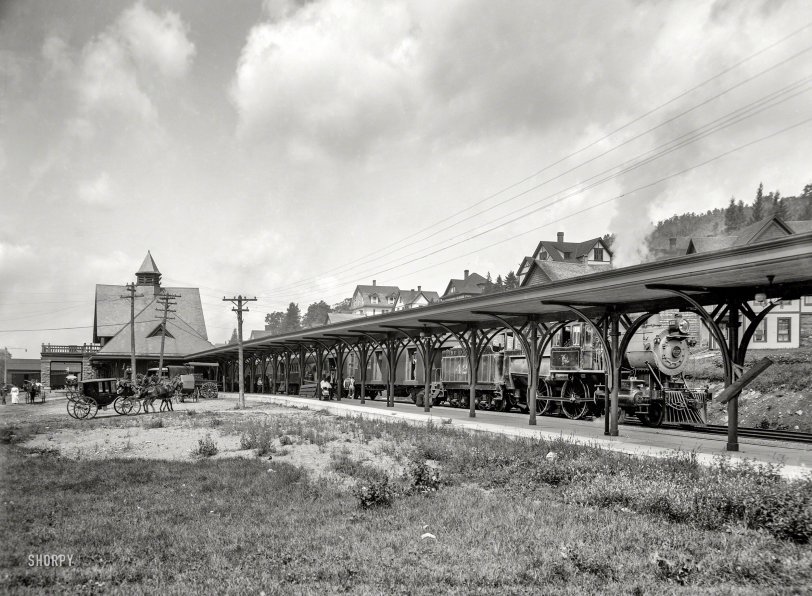


Framed or unframed, desk size to sofa size, printed by us in Arizona and Alabama since 2007. Explore now.
Shorpy is funded by you. Patreon contributors get an ad-free experience.
Learn more.

- S&P
- 1940 Zenith radio model 6G601
- Quality goes in before the name goes on!
- Snazzy skirt
- Carbon Arc Lamps
- Illuminate us
- I remember it well
- I can't prove it
- Complicated then, forgotten now
- Bryan-Stevenson
- Skinny is as skinny does
- How do you rest in peace
- Riding the footboards
- Alas, hidden from view
- Baldwin Diesels
- Exclusive pump
- Bananas, Oysters and Smokey Joe
- Details, Details
- What's that building to the left of the tower?
- Coal Barges
- Bromo-Seltzer
- Inner harbor
- The Basin
- What a headache!
- Giant stepladder?
- Yeah, it was cold
- Love those coats
- Link & Pin Days Remnant
- Baldwin 62303
- Baldwin VO-1000
Print Emporium
Saranac Lake: 1905

Circa 1905. "Saranac Lake central station, Adirondacks, N.Y." With a locomotive of the Delaware & Hudson Railway. 8x10 inch glass negative. View full size.
Pintsch Gas Lighting?
Beneath the platform canopy are what appear to be Pintsch Gas lighting fixtures. The view is not clear. It's possible that there's also an incandescent lamp on each fixture, between the two gas lamps.
Having gas-light "backup" was not uncommon in the early days of electric light. In 1905, Saranac Lake may well have had an independent electrical system not yet connected to a grid. This would justify a back-up method of lighting.
For snow or to know
I also noticed the item that perpster commented on.
My first guess is that's a kind of snow shovel. You hold on to the long board, and use the two flat boards at the bottom to clean snow off of the platform. You could probably shove a little of it over the far platform edge onto the tracks and not impede the trains; you could shove a lot of it over the near platform edge without hurting anything.
My second guess (which I think is less likely) is that it might have been some kind of marker or sign post. The two flat boards sit on the platform, and by itself, maybe it tells passengers about where the train would stop (so they don't wander all the way down the platform at random). With another sign hung on the long board, it might direct passengers to the first-class cars, or give the destination of the whole train.
Brushing Up
Stuck in the pillar roof supports all the way to the right in the image, is that a brush, or maybe a squeegee? At first I thought it was a loose or broken structural member, but it looks more like a platform maintenance tool, stored up there until needed.
Tri-Cocks
Visible thru the cab window are three valve handles arranged in a diagonal pattern. These are the tri-cocks - every steam locomotive has 'em.
Knowing the level of the water in the boiler of a locomotive is THE MOST important safety duty of both the engineer and the fireman on every steam locomotive. A glass tube, mounted in the cab, on the boiler (two on most engines) shows the engine crew exactly where the water level is in the boiler. The duties of both the engineer and the fireman include looking at the water glass every 15 seconds to be sure it is within the "safe" range.
The tri-cocks are a secondary check, to assure the accuracy of the waterglasses. Opening the top valve should emit steam. Opening the bottom valve should emit water. The middle valve could be either steam or water.
If not - find out why. NOW! You may be only seconds away from a boiler catastrophy!
Old Mother Hubbard
The locomotive is of the Camelback or "Mother Hubbard" variety - they had wide fireboxes to burn anthracite coal, necessitating moving the cab for the engineer forward - the fireman remained on a platform at the rear.

























On Shorpy:
Today’s Top 5